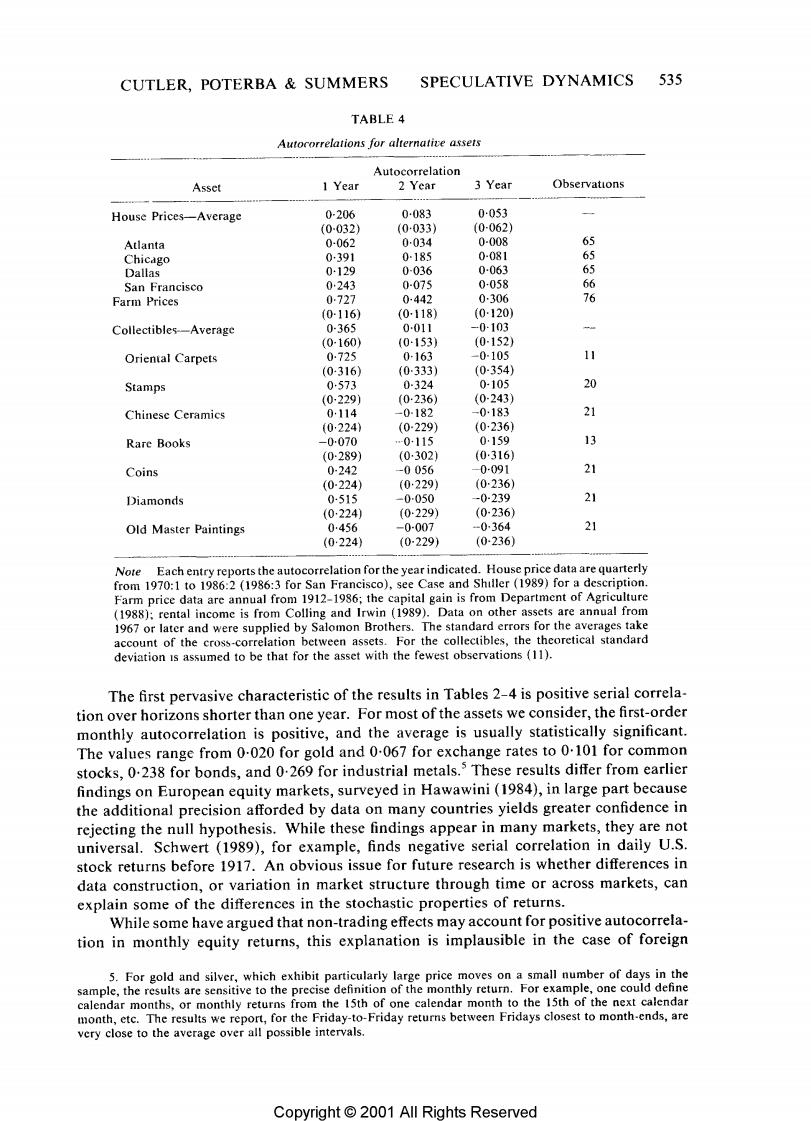正在加载图片...

CUTLER,POTERBA SUMMERS SPECULATIVE DYNAMICS 535 TABLE 4 Autocorrelations for alternatice assets Autocorrelation Asset 1 Year 2 Year 3 Year Observations House Prices-Average 0-206 0-083 0053 (0-032) (0033) (0-062) Atlanta 0-062 0034 0-008 65 Chicago 0391 0-185 0-081 65 Dallas 0-129 0-036 0-063 65 San Francisco 0243 0-075 0-058 66 Farm Prices 0-727 0-442 0-306 76 (0-116) (0-118) (0120) Collectibles--Average 0-365 0011 -0-103 (0-160) (0-153) (0-152) Oriental Carpets 0725 0-163 -0-105 11 (0-316) (0333) (0-354) Stamps 0573 0-324 0-105 20 (0229j (0-236) (0-243) Chinese Ceramics 0114 -0-182 -0183 (0224) (0229) (0-236) Rare Books -0-070 0-115 0159 13 (0289) (0302) (0-316) Coins 0-242 -0056 0-091 21 (0-224) (0·229) (0236) Diamonds 0-515 -0-050 -0-239 21 (0224) (0229) (0-236) Old Master Paintings 0456 -0-007 -0364 21 (0:224) (0-229) (0236) Note Each entry reports the autocorrelation for the year indicated.House price data are quarterly from 1970:1 to 1986:2 (1986:3 for San Francisco),see Case and Shiller (1989)for a description. Farm price data are annual from 1912-1986;the capital gain is from Department of Agriculture (1988);rental income is from Colling and Irwin (1989).Data on other assets are annual from 1967 or later and were supplied by Salomon Brothers.The standard errors for the averages take account of the cross-correlation between assets.For the collectibles,the theoretical standard deviation is assumed to be that for the asset with the fewest observations (11). The first pervasive characteristic of the results in Tables 2-4 is positive serial correla- tion over horizons shorter than one year.For most of the assets we consider,the first-order monthly autocorrelation is positive,and the average is usually statistically significant. The values range from 0-020 for gold and 0.067 for exchange rates to 0.101 for common stocks,0.238 for bonds,and 0.269 for industrial metals.These results differ from earlier findings on European equity markets,surveyed in Hawawini(1984),in large part because the additional precision afforded by data on many countries yields greater confidence in rejecting the null hypothesis.While these findings appear in many markets,they are not universal.Schwert (1989),for example,finds negative serial correlation in daily U.S. stock returns before 1917.An obvious issue for future research is whether differences in data construction,or variation in market structure through time or across markets,can explain some of the differences in the stochastic properties of returns. While some have argued that non-trading effects may account for positive autocorrela- tion in monthly equity returns,this explanation is implausible in the case of foreign 5.For gold and silver,which exhibit particularly large price moves on a small number of days in the sample,the results are sensitive to the precise definition of the monthly return.For example,one could define calendar months,or monthly returns from the 15th of one calendar month to the 15th of the next calendar month,etc.The results we report,for the Friday-to-Friday returns between Fridays closest to month-ends,are very close to the average over all possible intervals. Copyright 2001 All Rights Reserved